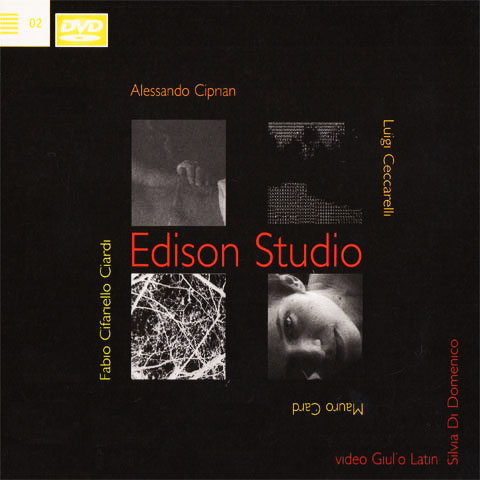
DVD – Auditorium EdiLDC278 1139/40
Edison Studio videos
Silvia di Domenico and Giulio Latini
music
Mauro Cardi – Altrove con il suo nome
Luigi Ceccarelli – Tupac Amaru (la deconquista, il Pachacuti)
Fabio Cifariello Ciardi – Games IV
Alessandro Cipriani – Still Blue (homage to Derek Jarman)
Coproduction Edison Studio – Cemat – Auditorium Edizioni (Milano)
Available on Amazon
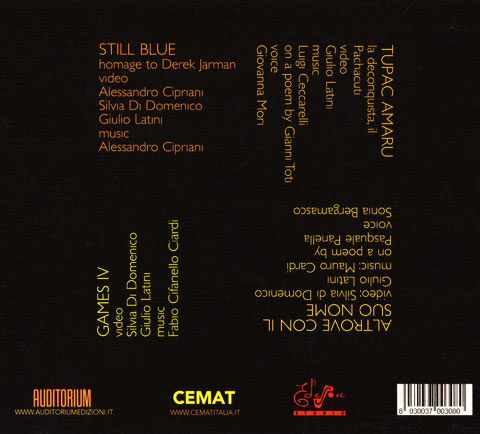
presentation by Bruno Marino
What do these four quite different videos have in common, apart from all being produced by Edison Studio and realized by Silvia Di Domenico and Giulio Latini, in collaboration with various composers such as Cardi, Ceccarelli, Cipriani and Cifariello Ciardi? Probably the idea that the image, any image, cannot be separated – either structurally or even ontologically – from the sound. This might not seem a very new discovery and it may not even seem to be particularly evident in these works, since in the field of electronic creation, especially now that we are in the digital age, visuals and sound are often generated together, with the same kinds of elaboration and processing (first analogical, then digital, and thus becoming decidedly immaterial). And yet the inextricable combination of these two components certainly cannot be reduced to a merely technological aspect. It is rather a matter of sensitivity.
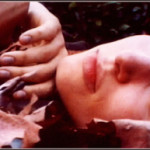 Although the genre of the “videoclip” – which has in fact now been expanded and simplified to apply to any image accompanying a piece of music, thereby broadening the range of visual-musical research – might at first sight seem somewhat insignificant or banal, in these four videos this type of experimental combination of the image and the sound is the result of a very particular and specific intention. Here it is immediately apparent that the two forms of expression (visual and musical) are equivalent and that neither one prevails or becomes a mere support for the other. Instead they seem to give a reciprocal creative input so as to support and nourish each other. Their creators (and one could call them video artists, video-makers, videographers, video directors, etc.) mostly realized their images on the basis of pre-existing musical compositions, although one video Altrove con il suo nome (“Elsewhere with his name”), was made in direct collaboration with the musician, thereby emphasizing the genesis and creation of this art-form and its double nature.
Although the genre of the “videoclip” – which has in fact now been expanded and simplified to apply to any image accompanying a piece of music, thereby broadening the range of visual-musical research – might at first sight seem somewhat insignificant or banal, in these four videos this type of experimental combination of the image and the sound is the result of a very particular and specific intention. Here it is immediately apparent that the two forms of expression (visual and musical) are equivalent and that neither one prevails or becomes a mere support for the other. Instead they seem to give a reciprocal creative input so as to support and nourish each other. Their creators (and one could call them video artists, video-makers, videographers, video directors, etc.) mostly realized their images on the basis of pre-existing musical compositions, although one video Altrove con il suo nome (“Elsewhere with his name”), was made in direct collaboration with the musician, thereby emphasizing the genesis and creation of this art-form and its double nature.
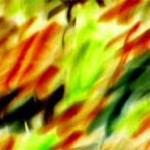 The overall result is like a sort of jam session at a distance, which is also chronological, in which the sounds inspire the visions and the images that are produced become nuances of the sounds. The abstractions of Games IV, consisting of electronic squiggles, trails of light, and the signs of nature or urban civilization that settle upon our retina thanks to a swirling rhythmic flow, are not very different from the seductive forms of Sonia Bergamasco filmed in Altrove con il suo nome. She seems to be returning to a chthonic, vegetable and ancestral dimension, with her body in-scribed in a dry sea of autumn leaves, which becomes a sort of magnetic landscape upon which to trace and combine two different kinds of writing: the literary one of Panella’s text and the musical one of Cardi. The actress’s body is indeed the instrument for the composition, since the various sounds are produced by sampling her voice.
The overall result is like a sort of jam session at a distance, which is also chronological, in which the sounds inspire the visions and the images that are produced become nuances of the sounds. The abstractions of Games IV, consisting of electronic squiggles, trails of light, and the signs of nature or urban civilization that settle upon our retina thanks to a swirling rhythmic flow, are not very different from the seductive forms of Sonia Bergamasco filmed in Altrove con il suo nome. She seems to be returning to a chthonic, vegetable and ancestral dimension, with her body in-scribed in a dry sea of autumn leaves, which becomes a sort of magnetic landscape upon which to trace and combine two different kinds of writing: the literary one of Panella’s text and the musical one of Cardi. The actress’s body is indeed the instrument for the composition, since the various sounds are produced by sampling her voice.
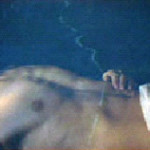 In Still Blue another body floats upon water. The liquid dimension is undoubtedly a classic theme of the video, as a natural place for electronic imagery. But in this case, the water and its refractions become a filter and a background upon which to dissolve a pictorial body: a Caravaggesque deposition that has a double allusion to Derek Jarman, since he directed the film “Caravaggio” as well as “Blue”, which told of his progressive sliding towards death. The music for piano, cello, saxophone and electronic elaborations gradually gives way to a voice, in the finale, which reads out the names of the friends of Jarman who have also died. The liquid, limpid and electronic blue of Cipriani-Latini-Di Domenico, compared to the grainy, monotonous and filmic blue of the English director, perhaps leaves less room for the imagination, but it becomes a sublime and reassuring metaphor of oblivion.
In Still Blue another body floats upon water. The liquid dimension is undoubtedly a classic theme of the video, as a natural place for electronic imagery. But in this case, the water and its refractions become a filter and a background upon which to dissolve a pictorial body: a Caravaggesque deposition that has a double allusion to Derek Jarman, since he directed the film “Caravaggio” as well as “Blue”, which told of his progressive sliding towards death. The music for piano, cello, saxophone and electronic elaborations gradually gives way to a voice, in the finale, which reads out the names of the friends of Jarman who have also died. The liquid, limpid and electronic blue of Cipriani-Latini-Di Domenico, compared to the grainy, monotonous and filmic blue of the English director, perhaps leaves less room for the imagination, but it becomes a sublime and reassuring metaphor of oblivion.
There is a sense of deep disquiet and of anguish in all of these works, with a conceptual instability of the image but also of the content. The mood of anxiety is mixed with sublime visions that suspend the videos between dream and nightmare (and this ambiguous dimension has become a recurring theme or trend in contemporary videos).
 The circle of poetry/video/music (also understood in the broadest sense as rhythm and metre), seems to be successfully closed with Tupac Amaru. It is no coincidence, in fact, that the poem on which this video is based is by the recently deceased Gianni Toti, who composed narrations in verse form, as well as creating videos, and who liked to define himself and his art with the word “poetronic”. Toti once staged a video trilogy of his poems based on the epic and dramatic history of Latin America. This video by Latini with music by Luigi Ceccarelli is a tribute to him, but it is also a theoretical statement of the need and the desire to be reconnected to an original type of research, like that of Toti, which is still so little known (or even acknowledged) in Italy, in which the word and the image merge into a single lyrical, playful, free and anarchic structure. In Tupac Amaru the triumph of the digital becomes a genuine texture and an abstract sea from which figurative fragments occasionally emerge to remind us that mankind – despite being crushed by the violence of History and the chaos of Nature – has not yet been completely shipwrecked or destroyed.
The circle of poetry/video/music (also understood in the broadest sense as rhythm and metre), seems to be successfully closed with Tupac Amaru. It is no coincidence, in fact, that the poem on which this video is based is by the recently deceased Gianni Toti, who composed narrations in verse form, as well as creating videos, and who liked to define himself and his art with the word “poetronic”. Toti once staged a video trilogy of his poems based on the epic and dramatic history of Latin America. This video by Latini with music by Luigi Ceccarelli is a tribute to him, but it is also a theoretical statement of the need and the desire to be reconnected to an original type of research, like that of Toti, which is still so little known (or even acknowledged) in Italy, in which the word and the image merge into a single lyrical, playful, free and anarchic structure. In Tupac Amaru the triumph of the digital becomes a genuine texture and an abstract sea from which figurative fragments occasionally emerge to remind us that mankind – despite being crushed by the violence of History and the chaos of Nature – has not yet been completely shipwrecked or destroyed.
